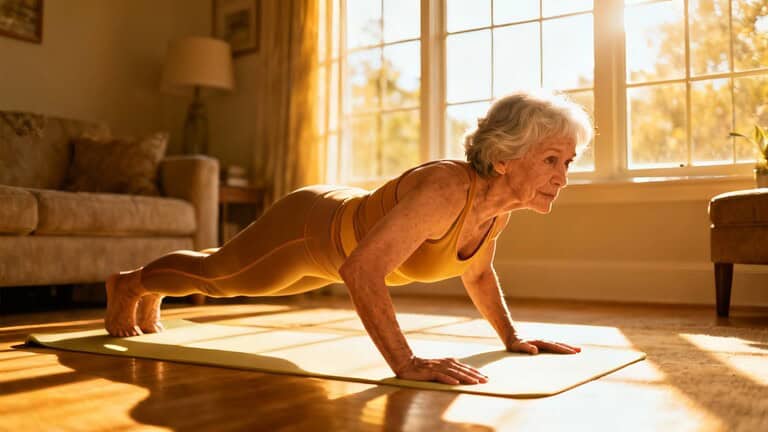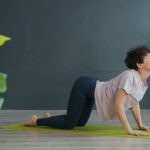Most people believe that achieving a toned midsection after 50 is impossible, but here’s a surprising reality: less than 10% of adults over 50 have a truly strong core.
Imagine yourself at 55 or even 65, moving with balance and stability while showing a firm abdomen that younger people would admire.
This isn’t just about aesthetics—it’s about protecting your spine, reducing fall risk, improving posture, and making everyday activities safer and easier.
Today, we’re sharing six science-backed at-home exercises that can literally transform how you age. These moves require no equipment and can be done in the comfort of your home, focusing on building functional strength that translates directly to better quality of life.
6. Mountain Climbers
At first glance, mountain climbers appear to be just another cardio move, but they’re actually one of the most powerful core-strengthening exercises you can do at home.
Every time you drive one knee toward your chest, your core must stabilize intensely to keep your body aligned. Your rectus abdominis, obliques, shoulders, arms, and hip flexors all work in harmony.
After 50, this exercise becomes particularly valuable because it mimics natural movements like climbing or walking uphill, training your body to stay stable under dynamic conditions. This translates to fewer stumbles, better posture, and less back strain in daily life.
How to do it safely:
- Begin in a high plank with shoulders stacked over wrists.
- Brace your core as if someone’s about to tap your stomach.
- Bring one knee toward your chest, pause briefly, then switch legs smoothly.
- Focus on control rather than speed.
- Start with three sets of 20-30 seconds, resting 15 seconds between sets.
5. Leg Raises
While most people think sit-ups are the king of ab training, they often strain the neck and spine more than they build core strength. Leg raises flip the script by forcing your lower abs—the most stubborn area for nearly everyone—to do the heavy lifting.
As we age, the lower abdomen tends to store more fat and lose tone faster. Weak lower abs mean less pelvic stability, more pressure on the lower back, and increased discomfort during daily movements. Leg raises directly target this weak link, building strength from the bottom up.
How to do it safely:
- Lie flat on your back with hands by your sides or tucked under your glutes.
- Press your lower back firmly against the floor.
- Slowly lift both legs to about 90 degrees, pause to feel the core squeeze, then lower with control, stopping just before your heels touch the ground.
- Start with three sets of 8-10 reps.
4. Bicycle Crunches
The American Council on Exercise ranked bicycle crunches as one of the most effective core moves ever tested. This exercise teaches your body to move the way it was designed to—using cross-body patterns that mimic walking, running, and climbing stairs.
Every twist of your torso engages your obliques, every leg extension fires the lower abs, and every shoulder lift activates the upper core. It’s a triple attack in one fluid motion that also sharpens coordination, balance, and cognitive function.
How to do it safely:
- Lie on your back with hands gently behind your ears, elbows wide.
- Lift your feet so shins are parallel to the ground.
- Extend your right leg while pulling your left knee in, rotating your torso so your right elbow moves toward your left knee.
- Switch sides in a smooth pedaling rhythm. Start with three sets of 10-12 reps per side.
3. Scissor Kicks
Scissor kicks look deceptively simple but are a hidden gem for building lower ab strength and deep core stability. As we age, loss of pelvic control and lumbar stability become common issues, leading to nagging lower back discomfort.
This exercise forces your core to stay tight while your legs move in opposite directions, training your abs to stabilize under dynamic stress—exactly what your body needs for walking on uneven ground or climbing stairs safely.
How to do it safely:
- Lie flat on your back with hands by your sides or tucked under your glutes.
- Press your lower back firmly into the floor.
- Lift both legs a few inches off the ground, then move one leg upward as the other lowers in a smooth scissoring motion.
- Start with three sets of 20-30 seconds.
2. Glute Bridge
While many people think the glute bridge is just a butt exercise, it’s actually one of the most effective ways to train your entire core. Modern life has us sitting for hours, leading to weak glutes, tight hip flexors, and an overworked lower back.
When you lift your hips, your glutes and hamstrings take the lead, but your transverse abdominis—the corset muscle wrapping around your midsection—must lock down to keep your pelvis steady. This creates perfect balance between backside power and front-side stability.
How to do it safely:
- Lie on your back with knees bent, feet flat on the floor hip-width apart.
- Press your heels down, brace your core, then drive your hips upward until your body forms a straight line from knees to shoulders.
- Squeeze your glutes hard at the top, hold for two seconds, then lower with control.
- Start with three sets of 12-15 reps.
1. The Plank
The plank takes the number one spot because it’s the ultimate test of core endurance and one of the most functional exercises you can do. Unlike crunches that only target the front abs, the plank recruits your entire trunk as one integrated unit.
Think of the plank as armor training—the stronger your core armor, the less pressure your spine absorbs during everyday movements. This means fewer backaches, better balance, and more energy to enjoy life. Best of all, you need no equipment and it’s accessible to everyone.
How to do it safely:
- Start on your forearms with elbows under shoulders, legs extended straight behind you.
- Press forearms and toes firmly into the ground.
- Squeeze your glutes and draw your belly button toward your spine.
- Keep your head neutral and breathe steadily.
- Begin with three sets of 20-30 seconds, resting 60 seconds between.
Important Safety Considerations
Before starting these exercises, remember that not every move fits everybody. If you’re dealing with uncontrolled high blood pressure, serious heart conditions, advanced osteoporosis, recent spinal injury, hernia, post-surgery recovery, or severe joint pain, consult your doctor or a qualified physical therapist first.
The goal is long-term health, not short-term risk. Train smart, listen to your body, and prioritize safety above all else.
Transform Your Core and Your Life
These six simple, equipment-free exercises can redefine your core and change how you age. Notice how each move focuses not just on abs but on balance, posture, back health, and real-life strength. A strong core is less about looking good in the mirror and more about living better every single day.
Imagine playing catch with your grandkids in your 60s, lifting groceries without pain, or climbing stairs without hesitation. That’s the gift of a resilient core—independence, confidence, and vitality packed into one.
The best part? You don’t need a gym membership, fancy machines, or hours of your time. Just a few minutes a day at home can create massive change if you stay consistent. Every second you hold that plank, every controlled rep of a leg raise is an investment in your future health.
Your body is more adaptable than you think. Start now, stay consistent, and watch how these small daily actions transform not only your core but your entire quality of life.








